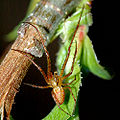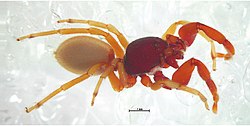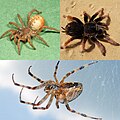The chelicerae (/kəˈlɪsəriː/) are the mouthparts of the subphylum Chelicerata, an arthropod group that includes arachnids, horseshoe crabs, and sea spiders...
9 KB (924 words) - 20:54, 24 May 2025
Solifugae (section Chelicerae)
the Solifugae are their large chelicerae, which in many species are longer than the prosoma. Each of the two chelicerae has two articles (segments; parts...
33 KB (3,438 words) - 05:30, 27 May 2025
Opiliones anatomy (section Chelicerae)
the abdomen and cephalothorax is often poorly defined. Harvestmen have chelicerae, pedipalps and four pairs of legs. Harvestmen were traditionally thought...
19 KB (2,464 words) - 18:17, 26 May 2025
Arthropod mouthparts (section Chelicerae)
ticks have a range of chelicerae. Carnivores have chelicerae that tear and crush prey, whereas herbivores can have chelicerae that are modified for piercing...
9 KB (1,101 words) - 08:43, 24 May 2025
Chelicerata (section Chelicerae and pedipalps)
mites, which have lost any visible division between these sections. The chelicerae, which give the group its name, are the only appendages that appear before...
84 KB (8,357 words) - 05:33, 24 May 2025
snakes. The eight legs, the two chelicerae with their fangs, and the pedipalps are attached to the prosoma. The chelicerae are two double-segmented appendages...
62 KB (6,882 words) - 04:53, 18 January 2025
from other groups in several features, especially in the chelicerae and the telson. The chelicerae of the Pterygotidae are enlarged and robust, clearly adapted...
34 KB (3,898 words) - 10:16, 25 May 2025
Two-segmented chelicerae is the ancestral condition in Acariformes, but in more derived groups they are single-segmented. And three-segmented chelicerae is the...
48 KB (5,035 words) - 20:38, 22 May 2025
scorpions, horseshoe crabs, and sea spiders. The pedipalps are lateral to the chelicerae ("jaws") and anterior to the first pair of walking legs. Pedipalps are...
7 KB (754 words) - 20:34, 23 May 2025
basal band, a central triangular spot, and two posterior oval spots. The chelicerae are large and iridescent green-blue-violet in color, with a tubercle on...
7 KB (593 words) - 22:41, 13 April 2025
described by Anton Menge in 1866. They have elongated bodies, legs, and chelicerae, and build small orb webs with an open hub with few, wide-set radii and...
9 KB (680 words) - 03:34, 19 June 2024
Atlantic Forest. The genus is characterized by the extremely modified male chelicerae and long pairs of ventral spines. It is the first fully revised endemic...
11 KB (726 words) - 14:06, 27 April 2024
"true spiders") are an infraorder of spiders. They are distinguishable by chelicerae (fangs) that point diagonally forward and cross in a pinching action,...
17 KB (603 words) - 18:39, 17 May 2025
segments), eight jointed legs, no wings or antennae, the presence of chelicerae and pedipalps, simple eyes, and an exoskeleton, which is periodically...
21 KB (2,561 words) - 06:29, 7 March 2025
differences include the fact that Opiliones have no venom glands in their chelicerae and thus pose no danger to humans. They also have no silk glands and therefore...
65 KB (7,144 words) - 12:28, 23 May 2025
which are tipped with small claws; then injecting venom with their hollow chelicerae to kill and digest the prey. They mainly eat insects, but some larger...
24 KB (2,378 words) - 15:00, 25 May 2025
arthropod legs as well as their pedipalps. Chelae are distinct from spider chelicerae in that they do not contain venomous glands and cannot distribute venom...
5 KB (571 words) - 14:59, 1 June 2025
snake venom). Spiders also have external fangs, which are part of the chelicerae. Fangs are most common in carnivores or omnivores, but some herbivores...
4 KB (364 words) - 18:13, 12 April 2025
jumping spiders easily identified by their large eyes and their iridescent chelicerae. Like all jumping spiders, they have excellent stereoscopic vision that...
32 KB (3,351 words) - 11:25, 25 May 2025
abdomen, sometimes dark grey. Notably, they have disproportionately large chelicerae for a spider of this size. Dysdera crocata is difficult to distinguish...
7 KB (763 words) - 02:56, 5 September 2024
three white stripes of setae on its cephalothorax, black setae on its chelicerae, and scattered dots and patterns of black and white setae on its abdomen...
3 KB (249 words) - 19:27, 10 March 2025
their spinnerets, while the Pisauridae carry their egg sacs with their chelicerae and pedipalps. Two of the wolf spider's eight eyes are large and prominent;...
26 KB (2,675 words) - 06:19, 26 May 2025
Feeding on an amphipod, showing chelicerae and pedipalp movement...
20 KB (2,585 words) - 12:17, 23 May 2025
enlarged spade-like front legs, and heads raised up on a "neck" with long chelicerae ("jaws"). Fossils suggest that the group was once widespread, but most...
11 KB (919 words) - 04:50, 11 December 2023
and many species are characterized by their brilliant, iridescent green chelicerae. Phidippus is distributed almost exclusively in North America, with the...
12 KB (958 words) - 08:08, 3 February 2024
Spiders (order Araneae) are air-breathing arthropods that have eight limbs, chelicerae with fangs generally able to inject venom, and spinnerets that extrude...
124 KB (13,698 words) - 02:40, 31 May 2025
with reddish brown or yellowish legs. The male has distinctive enlarged chelicerae (the mouthparts used for grasping prey) and front femora (the third, and...
20 KB (1,897 words) - 17:55, 28 May 2025
flattened telsons (the most posterior segment of the body) and their modified chelicerae (frontal appendages), ending in well-developed chelae (claws). Many pterygotid...
34 KB (3,793 words) - 01:43, 24 May 2025
its relative D. crocata, this spider uses its disproportionately huge chelicerae to kill woodlice, as well as silverfish, earwigs, millipedes, beetles...
2 KB (126 words) - 19:13, 23 August 2022
chelicerae are very diverse between species, but they are generally very long with small curved teeth without serrations. Studies on the chelicerae and...
33 KB (3,625 words) - 22:47, 24 May 2025




























